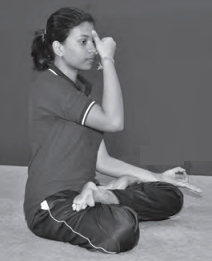The Anuloma means ‘towards’ and Viloma means ‘reverse’. It is called Anuloma-viloma because alternate nostrils are used for each inhalation and exhalation. One inhales through the left nostril and then exhales through the right nostril , then the order is reversed by inhaling through the right nostril, and exhaling through the left nostril. This pranayama is called Nadi-shodhana pranayama also, if it is performed with kumbhaka (holding the breath).

Let us perform Anuloma-viloma by following the steps given below:
1. Sit in the position of Padmasana or in any other comfortable meditative posture.
2. Keep the body erect and place the hands on the respective knees.
3. Raise the right hand and place the right thumb on the right nostril and close it.
4. Inhale slowly through the left nostril.
5. Close the left nostril by the ring finger and the little finger and exhale slowly through the right nostril.
6. Again inhale through the right nostril.
7. Close the right nostril with thumb and exhale through the left nostril. This is one round of Anuloma-viloma.
8. Repeat it 10 times.
Remember the following points:
| Dos |
Don’ts |
| Inhale the air slowly without bulging the abdomen |
Avoid producing sound from the nose. |
| Keep the ratio of 1:1 or 1:2 between the inhalation and the exhalation. |
Do not press hard on the nostrils. |
|
Avoid retaining breath (kumbhaka) in the beginning. |
Benefits
- It calms down the mind and improves concentration.
- It improves functioning of all cells of the body by providing them sufficient oxygenated blood.
- It purifies the blood.
- It improves blood supply to brain.
- It helps to regulate blood pressure.
- It helps in managing stress by reducing anxiety.
- It is beneficial in many diseases such as asthma, high or low blood pressure, insomnia, chronic pain, endocrine imbalances, heart-problems, hyperactivity, etc.
Limitation
- In the beginning, retention of breath should be avoided.